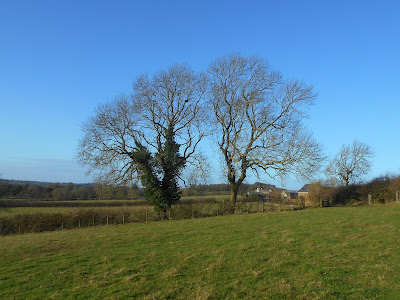 |
A newly-laid hedge on the western border of Foxhill Farm.
8 December, 2018
|
Laid hedges have existed in Britain for many centuries, certainly since Saxon times, although to go back any further is problematic.
In this area hawthorn is by far the favourite tree for the purpose. It is moderately thorny but not viciously so and is quick to recover from the trauma of the laying process. Well over 90% of the hawthorn in this area is Common Hawthorn, Crataegus monogyna. Other names are may, quickthorn and whitethorn. It has quite deeply lobed leaves and, although hybrids are frequent the pure species is instantly recognisable.
Far less common is the Midland Hawthorn, Crataegus laevigata. It has shallowly lobed leaves and again although I have encountered hybrids, the 'real thing' is distinctive. The two species harbour, as far as I know, the same mites, caterpillars, bugs and beetles.
In some cases a laid hedge will retain a few trees to grow on and perhaps provide shade for livestock. Ash, Fraxinus excelsior, will quickly colonise a hedge and growth can be rapid. It can be laid along with the hawthorn and was to some extent encouraged a couple of centuries back, its timber being useful for a variety of tasks. Significant gaps can however develop in the hedge beneath an ash tree and to some extent its shade may be responsible. A more significant problem however is the spread of its considerable root system which will rob the surrounding soil of water and mineral salts.
 |
Ash trees in a hedgerow at Foxhill Farm. Note the rather 'gappy' hedge
to the right of the trees. 8 December, 2018
|
In some respects Blackthorn, Prunus spinosa, makes a better hedgerow, with its long and very sharp thorns deterring, if not cattle, certainly any humans bent on mischief. A significant drawback to the use of blackthorn lie in its tendency to throw out runners. As the photograph shows, these form a thicket of new growth a few feet from the parents. Modern equipment makes short work of these but a few decades back the constant removal of this growth must have been an irksome task.
 |
Blackthorn runners throwing up new growth.
Foxhill Farm. 8 December, 2018
|
Today, besides strolling along and musing about hedges I was, as ever, on the lookout for invertebrates. Despite the chilly conditions (about 10 degrees Celsius but with a strong wind) a few seven-spot ladybirds were about but little else. Not until, that is, I found some uprooted tree stumps to investigate.
 |
Uprooted tree stumps formed an interesting habitat for me to
investigate. Foxhill Farm, 8 December, 2018
|
Some of the stumps were elder, Sambucus nigra, a hedgerow plant par excellence. It is not everyone's favourite but I have a soft spot for it, not least because it supports a surprising variety of wildlife. Not today of course, standing leafless or dead, although in fact even the dead branches have their points of interest, with Elder Whitewash, Hyphodontia sambuci, very evident. Common names can be pointless, even silly, but this fungus really does give the impression that someone has smeared the wood with white emulsion paint.
 |
| Elder Whitewash on a dead branch. Foxhill Farm, 8 December, 2018 |
A close examination of the rotting wood and loose bark revealed several beetles and bugs. The beetles will be a challenge as they aren't really my speciality and some were less than 3 mm long. The bugs were specimens of Drymus sylvaticus. This is a widespread species and, as the specific name indicates, it is frequently found in woodlands (Latin sylva, wood). Pleasingly it was a new species for the farm.
So having demonstrated unbridled courage in facing the weather I felt the effort was worth it.
.


No comments:
Post a Comment